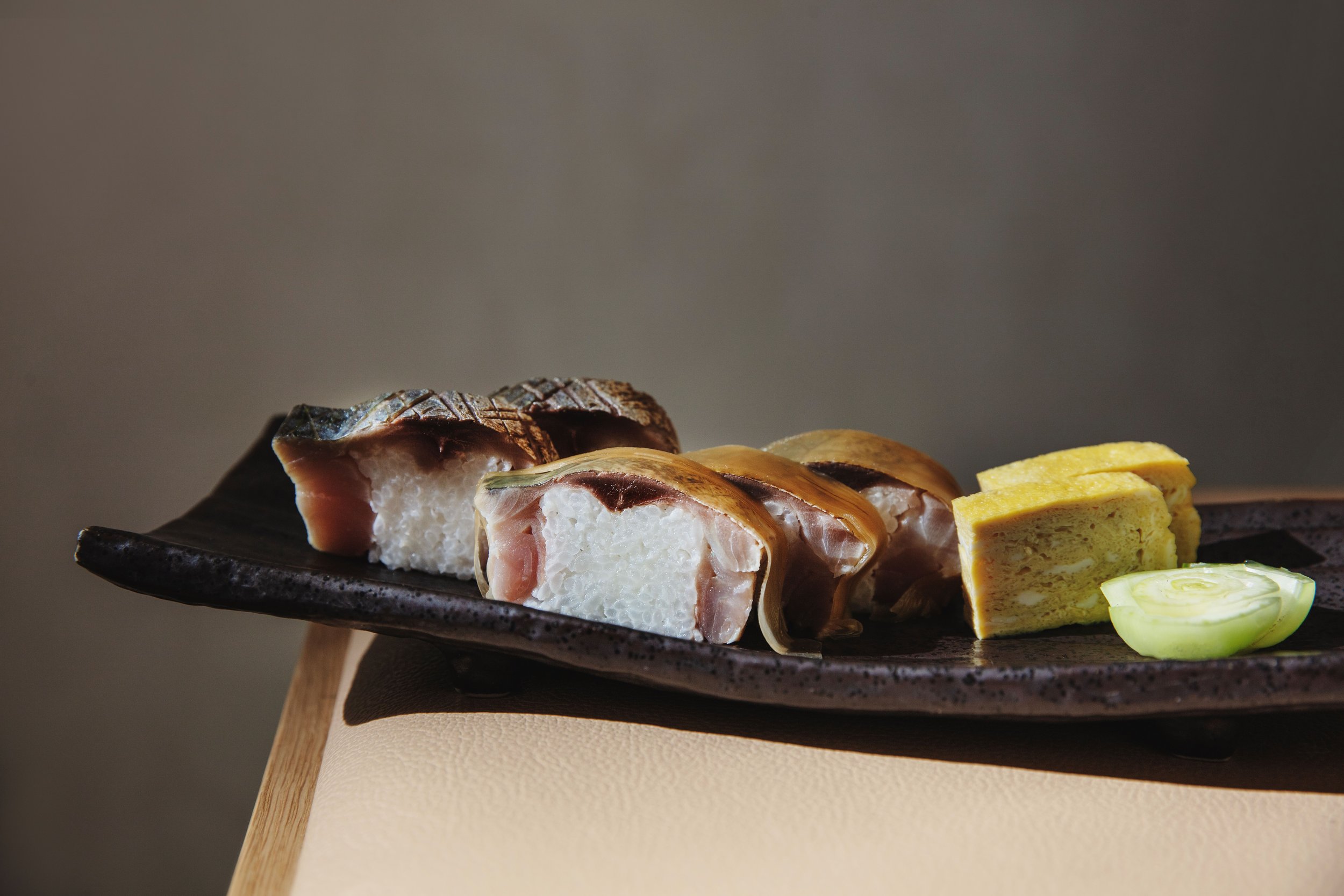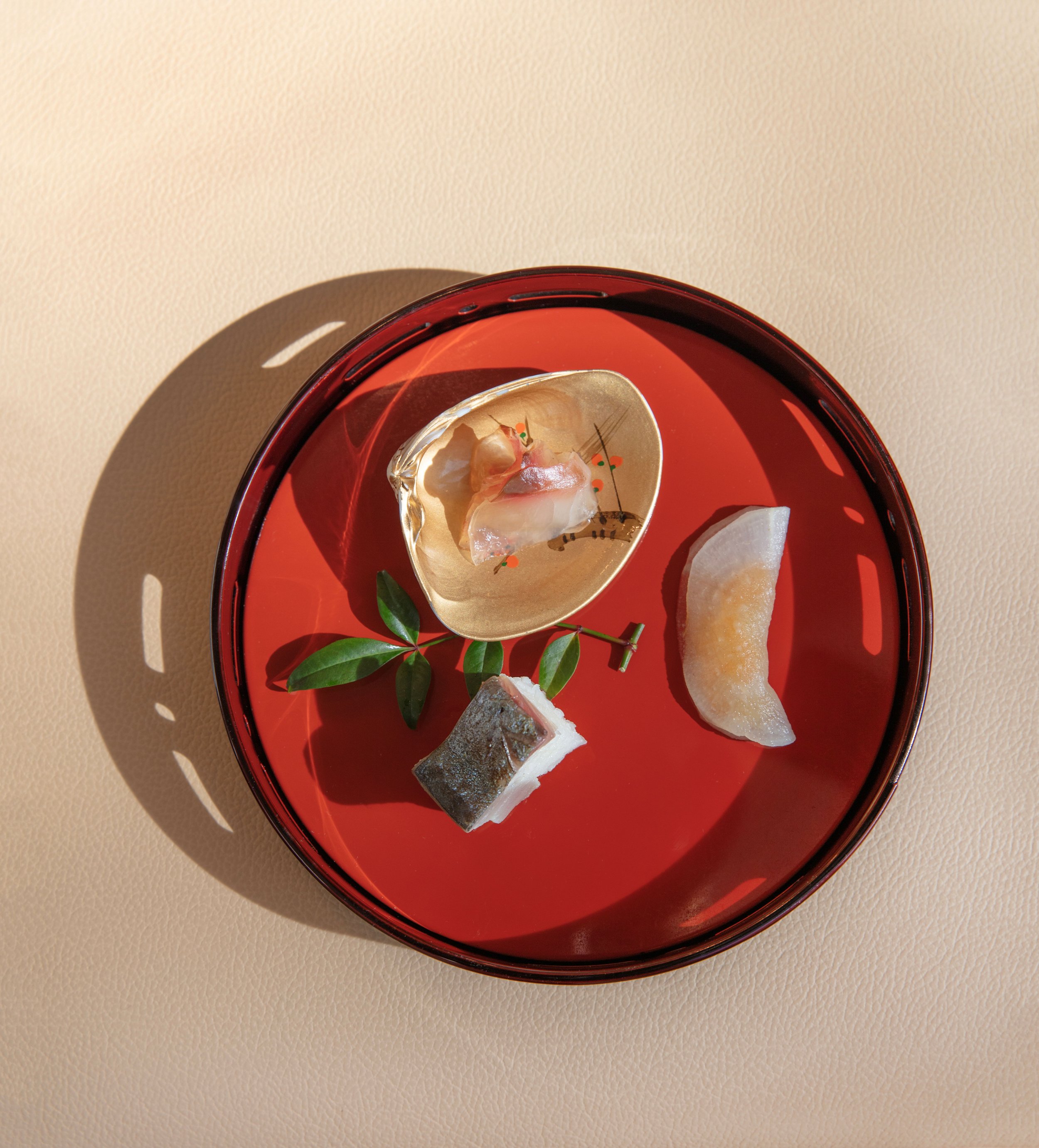Leave It Up to the Chef
A Culinary Journey into the Art of Omakase Sushi
by Craig Kaminer / Photos by Carmen Troesser
In the world of gastronomy, few dining experiences rival the artistry and intimacy of omakase sushi. It is a culinary adventure where diners relinquish control and trust the chef to guide them on a journey of flavors, textures, and stories.
Whether in the heart of Tokyo, overlooking the Manhattan skyline, or off the beaten path in St. Louis, omakase sushi offers a glimpse into the soul of Japanese cuisine. It is a celebration of simplicity, craftsmanship, and the profound connection between food and culture.
For those willing to embark on this gastronomic journey, prepare to be dazzled by the skill of the sushi chef, delighted by the freshness of the ingredients, and enchanted by the symphony of flavors. Omakase sushi is not just a meal—it is something to savor, a memory to cherish, and a testament to the enduring allure of Japanese culinary artistry.
Nobu prepared saba consisting of mackerel from Japan Mackeral, tamago, and bok choy.
While omakase refers to chef’s choice, the fixed menu style is popular with many different chefs and cuisines. Not having the chance to select your favorite thing on the menu is both limiting and liberating. Nothing served is too scary, but the experience will challenge you to try new things, explore different taste and texture profiles, and ultimately to really enjoy the food. Condiments – except those on the food as they are presented – are discouraged. George Kidera, the son of famed St. Louis sushi chef Nobu, laments that many guests want to use a lot of soy sauce but he encourages everyone to try everything first the way the chef prepares it.
Bonito from Japan with myoga ginger, Alaskan salmon roe, and wagyu beef.
Noboru Kidera, the 76-year-old master sushi chef known as Nobu, is not to be confused with Nobu Matsuhisa with 56 restaurants in 36 hotels around the world including New York, Los Angeles, Miami, and Aspen. The senior Kidera came to St. Louis in 1987. He grew up in Kobe, Japan, started working as an apprentice at the age of 19, and apprenticed for more than nine years. His chef skills took him first to Hawaii, before landing in St. Louis 36 years ago as one of the only local sushi chefs. He started at Tachibana in Creve Coeur as he saved enough money to start his own restaurant, Nobu, at the corner of Delmar and Old Bonhomme. After three years, Nobu moved to a former Pancake House location on Olive Boulevard east of I170. He remained there for almost 30 years until the developers of Costco came with an offer to move that he could not refuse.
Quintessential Nobu with his big smile and warm personality.
With Covid raging, Nobu and his family used the time to plan an omakese sushi restaurant, a concept not seen very often here. Sasha Malinich of S. Aleksandr Malinich Design, who designs award-winning restaurants and retail spaces around the country, helped conceive of the modern Japanese design. After six months of designing and plotting the launch of the most intimate sushi restaurant in St. Louis, Nobu’s opened in October 2022. Dinner is only served four nights a week from Wednesday to Saturday.
Hidden away in a somewhat unmarked storefront at 6253 Delmar, Nobu’s is unlike any other local restaurant. It places the guests up front and personal with Nobu himself.
On the nights they are open, you will find the three Kidera family members (Nobu, his wife Taeko and son George) waiting on just 10-12 guests, with the experience lasting 90-120 minutes or more. There are three omakase offerings: three courses for $80, four courses for $120, and six courses for $160 plus the cost of sake pairings, wine, beer or tea, plus tax, and gratuity. This is not for the budget-conscious but you will be surprised how some of their diners are young – frequently WashU students – looking to experience a higher level of sushi.
Taeko, Nobu and George pose at the best table in Nobu’s.
Throughout the restaurant are Taeko’s beautiful botanical and floral designs. Her Ikebana creations are set at various points within the space with the 'ancient' Bonsai provided by Manasseh Bartley.
Omakase means chef’s choice so while they will adjust the menu based on allergies and dietary restrictions, don’t plan on eating the old sushi standbys. That shouldn’t deter you. Nobu is a master and prides himself on presenting things that most people haven’t had, but he does not shock the diner with the ingredients. When you check in or sit down, you will be asked what you don’t like. They frequently cater to vegans and vegetarians too so don’t worry if you don’t eat fish or shellfish. From that point forward, Nobu will make every attempt to impress you with the freshest sushi in St. Louis, often flown in from Japan or procured from local fishmongers, with seasonal ingredients and edible garnishes. No fake seaweed here.
Traveler fish, kumquat wrapped in a pickled turnip, and a smaller bite size of the ba-tera.
An omakase experience is intimate and not something you want to rush. It frequently takes 90 minutes (or more), depending on the number of courses, the wine or sake pairings, the extensive explanations by Nobu or George, and of course, the time to savor the sushi and all of the seasonal flavors. While the restaurant seats 16 – 11-12 at tables and up to six at the sushi counter, there are usually on average just 10-12 people sharing an intimate experience hearing stories about the fish, the preparation, where the ingredients come from, and Nobu’s colorful stories of Japan.
On the night my wife and I went to experience it firsthand, we ordered the three-course menu plus the sake pairings with each course. First up was a dish called “nuta” which consists of three pieces of seafood (tuna, salmon, and snapper or shima-aji) tossed in karashi-miso (yellow miso mustard) accompanied by vegetable garnish also pre-marinated with sushi vinegar. The second course was a clear miso soup made from red snapper bone broth with some pieces of the snapper. Then we were served a bowl of sashimi consisting of perfectly prepared o-toro, yellowtail or shima-aji and sea urchin (uni) followed by a generous sushi course with eight nigiri pieces without too much rice. Each piece was flavorful, delicate, and unlike any other sushi I have had in St. Louis. With each course, Nobu or George told us what everything was, where it came from, and how it was prepared.
Presentation of miso with fresh snapper bone both.
For this story, Nobu prepared saba (also known as be-tera), or a southern Japanese interpretation of rolls, consisting of mackerel from Japan which is cured for several hours, with a slightly sweet vinegar-based kelp on top that counteracts the gaminess of the mackerel with compressed rice to absorb the fish oils. It is a fermented dish and can be eaten for several days following because of the fermentation. To add color and variety to the course, Nobu made his own special tomago, with fish bone broth mixed with egg and prepared like an omelet. The plate was garnished with a marinated stem of bok choy. Each of the preparations were created with different marination ratios adding to the subtlety of the entire plate.
Nobu and Taeko making bone broth from red snapper.
Next up was a three-part tasting menu consisting of traveler fish (cured in salted kelp, rested for six-to-12 hours), kumquat wrapped in a pickled turnip, and a smaller bite-size of the ba-tera which is typically served on their six course offering.
Perhaps my favorite part of the meal was the seafood salad with Dungeness crab, fresh ginger from Fiji, pressure-cooked sardines from Japan (typically topped with tomato, peppers, plums or okra), raw sweet shrimp topped with fresh wasabi from Japan, and garnished with a seasonal bamboo shoot called takenoko, Japanese pumpkin, yam leaf wrapped around red snapper or shima-aji taken near the bone of the fish when grilled, and hydroponically grown watercress, oak leaf or red gem from locally owned Vertigreens. Nobu also used cherry tomatoes, golden berry, sato-imo (potato) with yuzu-miso, arrow root marination, and marinated spinach.
Seafood salad with Dungeness crab, pressure-cooked sardines from Japan, raw sweet shrimp, and garnished with seasonal vegetables.
In addition to Vertigreens, Nobu’s also sources some of organic vegetables (daikon radish, hakurei turnip, mokum carrots, scallion, Japanese shishito peppers, eggplant, cucumbers, pasture raised eggs) from Darlene and Ryan Smith at Lucky Dog Farm in Wentzville, MO.
The final preparation was bonito from Japan called katsuo with Japanese myoga ginger from Takachi Prefecture Shikoku Island, Alaskan salmon roe, wagyu beef, and served with a small glass of Pinot Noir.
Taeko and Nobu prepping food for busy night.
While chances are good that you will be served similar things when you treat yourself to Nobu’s, the menu is always evolving and changing subtlety on a weekly basis. But you can always expect the ingredients to hail from the highest quality sources and as Nobu says, “We use from nose to tail, and stem to leaf.”
For those who think this sounds over the top, it isn’t.
“If you don’t know how to approach these dishes, I recommend starting with a vegetable, then a protein, then a vegetable, going back and forth between vegetable and protein,” George said. Carefully listening in the background, Nobu smiled and nodded.
“This is how Nobu eats so I think it is the proper way,” George added. But he reminds me that nothing is written in stone and each dish should be consumed the way the guest wants. So I did.
I asked George how much education of omakase has the St. Louis public required. “Many people use too much soy” George said, ”It overtakes what is being served. We brush on house-made soy sauce at just the right amount. We are not offended if you want more soy and wasabi, but we ask that you try it the way it is presented before you do it your way.
While omakase is new to St. Louis, chef’s choice sushi is not. In New York City, for example, zoomakase (zoom + omakase) is the newest trend; it’s served in under an hour and costs under $100. If successful, it will likely come here, too.
George acknowledges the risk of doing omakase in St. Louis because it is unique and guests sometimes feel like they are walking into the unknown. But in the 16 months since Nobu’s opened, reservations have been steady and are often hard to get on short notice.
Recently, Nobu has been awarded the Chef of the Year by the St. Louis Post-Dispatch, Best Sushi by the RFT, and an Editor’s Choice Award by St. Louis Magazine’s food editor, George Mahe.
So if you are interested in food experiences, skip the long flight to Japan, and get a reservation at Nobu’s as soon as you can.
We wanted to include chef Nick Bognar of Sado and the soon-to-open Pavillion in this story but unfortunately, Nick suffered an injury the day before the interview and photo shoot.










